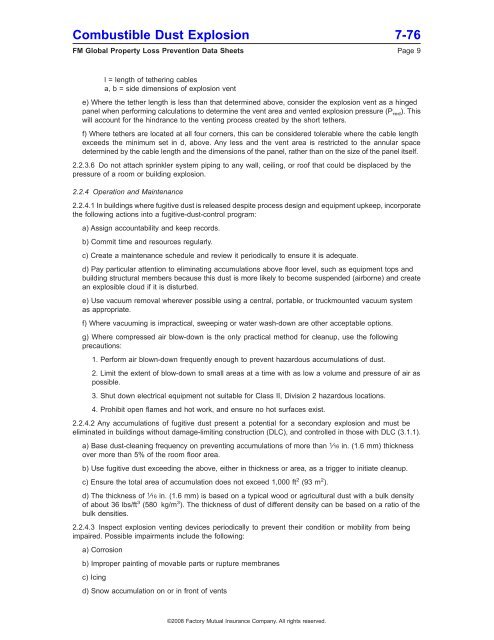DS 7-76 Prevention and Mitigation of Combustible Dust ... - FM Global
DS 7-76 Prevention and Mitigation of Combustible Dust ... - FM Global
DS 7-76 Prevention and Mitigation of Combustible Dust ... - FM Global
You also want an ePaper? Increase the reach of your titles
YUMPU automatically turns print PDFs into web optimized ePapers that Google loves.
<strong>Combustible</strong> <strong>Dust</strong> Explosion 7-<strong>76</strong><br />
<strong>FM</strong> <strong>Global</strong> Property Loss <strong>Prevention</strong> Data Sheets Page 9<br />
l = length <strong>of</strong> tethering cables<br />
a, b = side dimensions <strong>of</strong> explosion vent<br />
e) Where the tether length is less than that determined above, consider the explosion vent as a hinged<br />
panel when performing calculations to determine the vent area <strong>and</strong> vented explosion pressure (P red). This<br />
will account for the hindrance to the venting process created by the short tethers.<br />
f) Where tethers are located at all four corners, this can be considered tolerable where the cable length<br />
exceeds the minimum set in d, above. Any less <strong>and</strong> the vent area is restricted to the annular space<br />
determined by the cable length <strong>and</strong> the dimensions <strong>of</strong> the panel, rather than on the size <strong>of</strong> the panel itself.<br />
2.2.3.6 Do not attach sprinkler system piping to any wall, ceiling, or ro<strong>of</strong> that could be displaced by the<br />
pressure <strong>of</strong> a room or building explosion.<br />
2.2.4 Operation <strong>and</strong> Maintenance<br />
2.2.4.1 In buildings where fugitive dust is released despite process design <strong>and</strong> equipment upkeep, incorporate<br />
the following actions into a fugitive-dust-control program:<br />
a) Assign accountability <strong>and</strong> keep records.<br />
b) Commit time <strong>and</strong> resources regularly.<br />
c) Create a maintenance schedule <strong>and</strong> review it periodically to ensure it is adequate.<br />
d) Pay particular attention to eliminating accumulations above floor level, such as equipment tops <strong>and</strong><br />
building structural members because this dust is more likely to become suspended (airborne) <strong>and</strong> create<br />
an explosible cloud if it is disturbed.<br />
e) Use vacuum removal wherever possible using a central, portable, or truckmounted vacuum system<br />
as appropriate.<br />
f) Where vacuuming is impractical, sweeping or water wash-down are other acceptable options.<br />
g) Where compressed air blow-down is the only practical method for cleanup, use the following<br />
precautions:<br />
1. Perform air blown-down frequently enough to prevent hazardous accumulations <strong>of</strong> dust.<br />
2. Limit the extent <strong>of</strong> blow-down to small areas at a time with as low a volume <strong>and</strong> pressure <strong>of</strong> air as<br />
possible.<br />
3. Shut down electrical equipment not suitable for Class II, Division 2 hazardous locations.<br />
4. Prohibit open flames <strong>and</strong> hot work, <strong>and</strong> ensure no hot surfaces exist.<br />
2.2.4.2 Any accumulations <strong>of</strong> fugitive dust present a potential for a secondary explosion <strong>and</strong> must be<br />
eliminated in buildings without damage-limiting construction (DLC), <strong>and</strong> controlled in those with DLC (3.1.1).<br />
a) Base dust-cleaning frequency on preventing accumulations <strong>of</strong> more than 1 ⁄16 in. (1.6 mm) thickness<br />
over more than 5% <strong>of</strong> the room floor area.<br />
b) Use fugitive dust exceeding the above, either in thickness or area, as a trigger to initiate cleanup.<br />
c) Ensure the total area <strong>of</strong> accumulation does not exceed 1,000 ft 2 (93 m 2 ).<br />
d) The thickness <strong>of</strong> 1 ⁄16 in. (1.6 mm) is based on a typical wood or agricultural dust with a bulk density<br />
<strong>of</strong> about 36 lbs/ft 3 (580 kg/m 3 ). The thickness <strong>of</strong> dust <strong>of</strong> different density can be based on a ratio <strong>of</strong> the<br />
bulk densities.<br />
2.2.4.3 Inspect explosion venting devices periodically to prevent their condition or mobility from being<br />
impaired. Possible impairments include the following:<br />
a) Corrosion<br />
b) Improper painting <strong>of</strong> movable parts or rupture membranes<br />
c) Icing<br />
d) Snow accumulation on or in front <strong>of</strong> vents<br />
©2008 Factory Mutual Insurance Company. All rights reserved.

















